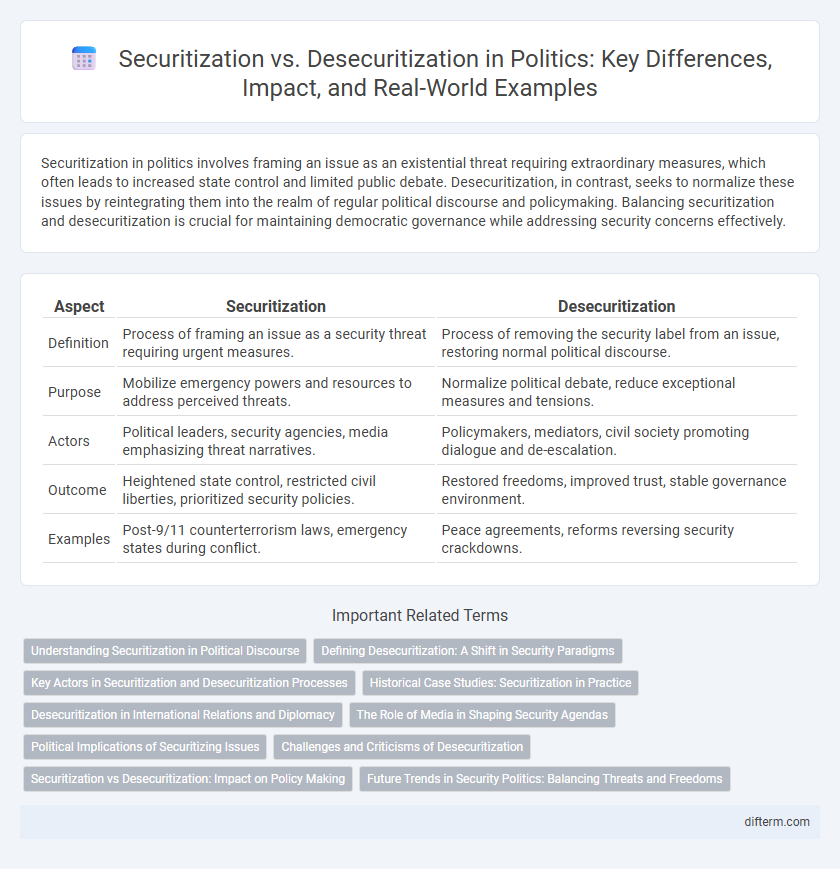Securitization in politics involves framing an issue as an existential threat requiring extraordinary measures, which often leads to increased state control and limited public debate. Desecuritization, in contrast, seeks to normalize these issues by reintegrating them into the realm of regular political discourse and policymaking. Balancing securitization and desecuritization is crucial for maintaining democratic governance while addressing security concerns effectively.
Table of Comparison
| Aspect | Securitization | Desecuritization |
|---|---|---|
| Definition | Process of framing an issue as a security threat requiring urgent measures. | Process of removing the security label from an issue, restoring normal political discourse. |
| Purpose | Mobilize emergency powers and resources to address perceived threats. | Normalize political debate, reduce exceptional measures and tensions. |
| Actors | Political leaders, security agencies, media emphasizing threat narratives. | Policymakers, mediators, civil society promoting dialogue and de-escalation. |
| Outcome | Heightened state control, restricted civil liberties, prioritized security policies. | Restored freedoms, improved trust, stable governance environment. |
| Examples | Post-9/11 counterterrorism laws, emergency states during conflict. | Peace agreements, reforms reversing security crackdowns. |
Understanding Securitization in Political Discourse
Securitization in political discourse involves framing an issue as an existential threat requiring emergency measures beyond normal political procedures. This process enables actors to justify extraordinary policies by portraying specific subjects--such as immigration, terrorism, or climate change--as security challenges demanding urgent action. Desecuritization seeks to reverse this framing, normalizing the issue within standard political debate to avoid fear-driven policies and promote democratic deliberation.
Defining Desecuritization: A Shift in Security Paradigms
Desecuritization involves the deliberate removal of issues from the security agenda, reframing them as normal political or social matters to reduce perceived threats. This shift challenges traditional security paradigms by promoting dialogue and cooperation over militarized or emergency responses. By redefining threats, desecuritization facilitates conflict resolution and the normalization of relations in international and domestic politics.
Key Actors in Securitization and Desecuritization Processes
Key actors in securitization processes include political leaders, security experts, and media outlets who frame issues as existential threats to justify exceptional measures. In contrast, desecuritization involves legislators, civil society groups, and international organizations working to reframe these threats as normal political issues, thereby reducing emergency politics. The interplay between these actors shapes policy responses and public perception of security challenges.
Historical Case Studies: Securitization in Practice
Historical case studies of securitization reveal how states construct threats to justify extraordinary measures, such as the U.S. government's framing of terrorism post-9/11, which led to the Patriot Act and enhanced surveillance protocols. The Cold War era illustrates securitization through the containment doctrine, where the Soviet Union was portrayed as an existential threat, legitimizing military buildup and foreign interventions. These cases demonstrate how securitization shapes political agendas by transforming issues into matters of national security, often sidelining democratic debate and normal policy processes.
Desecuritization in International Relations and Diplomacy
Desecuritization in international relations involves shifting issues from emergency security frames to normal political processes, thereby reducing perceived threats and fostering dialogue among states. This approach encourages diplomatic engagement and confidence-building measures to resolve conflicts without resorting to coercive or militarized tactics. Effective desecuritization contributes to sustainable peace by normalizing contentious issues within international negotiations and multilateral institutions.
The Role of Media in Shaping Security Agendas
Media outlets play a crucial role in securitization by framing issues as security threats, influencing public perception and political agendas. The framing techniques and language used in news coverage amplify or downplay risks, thereby shaping policy responses and legitimizing extraordinary measures. Desecuritization occurs when media shifts focus away from threat narratives, promoting normalization and reducing the perceived urgency of security concerns.
Political Implications of Securitizing Issues
Securitization transforms political issues into matters of security, justifying extraordinary measures and often limiting democratic debate. This process can concentrate power within executive branches and increase surveillance or military interventions, affecting civil liberties. Desecuritization reverses these effects by normalizing issues, promoting political pluralism and dialogue within institutional frameworks.
Challenges and Criticisms of Desecuritization
Desecuritization faces challenges in balancing the reduction of security measures without undermining legitimate threats, often leading to political resistance and public skepticism. Critics argue desecuritization may downplay or ignore emerging risks, resulting in policy vacuums and weakened state capacity to respond effectively. Furthermore, the process demands nuanced context-specific approaches, complicating consensus among stakeholders and risking inconsistent security governance.
Securitization vs Desecuritization: Impact on Policy Making
Securitization elevates issues to urgent threats, prompting rapid policy responses often characterized by exceptional measures and resource allocation toward security. Desecuritization reduces the perceived threat level, allowing policies to shift from emergency frameworks to normalized governance, emphasizing dialogue and long-term solutions. The balance between securitization and desecuritization critically shapes the scope, urgency, and legitimacy of policy making in political contexts.
Future Trends in Security Politics: Balancing Threats and Freedoms
Future trends in security politics emphasize balancing the intensification of securitization with the imperative of desecuritization to protect civil liberties. Governments increasingly adopt advanced surveillance technologies and proactive threat detection while facing pressures to ensure transparency and prevent authoritarian overreach. This dynamic interplay shapes policy frameworks aimed at safeguarding national security without compromising democratic freedoms.
Securitization vs Desecuritization Infographic

 difterm.com
difterm.com